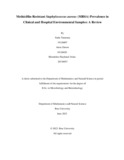| dc.description.abstract | The potential function of polluted ambient surfaces as a methicillin-resistant Staphylococcus
aureus (MRSA) reservoir in medical facilities is the topic of discussion in this paper review. The
Staphylococcus aureus bacteria is known as methicillin-resistant Staphylococcus aureus.
Multiple-resistant S. aureus is distinguished by its resistance to the antibiotic methicillin and to
related semi-synthetic penicillin. Over the years, especially in the past decade, the infection rate
of MRSA has become prevalent. In this review, the main focus was on the colonization of
MRSA on clinical and nosocomial surfaces. Maximum MRSA colonization occurred on the
equipment doctors and health care personnel used. Like scissors, syringes, injections, etc. On the
other hand, patients with different diseases and different injury cases are infected by MRSA. So,
in health care units (ICUs), there are bed rails, bedside tables, door knobs, handle locks, and
many other different materials that have been colonized with MRSA. MRSA infection affected
patients’ lungs, urethra, wounds, genitals, urine, blood, body fluids, eye sights etc. Then,
country-based infection was most prevalent in Bangladesh, Pakistan, Germany, India, Brazil,
Ukraine, Japan, the UK, and the USA, and the prevalence rate was increasing in these countries.
Different samples from patients were also collected for MRSA screening, like blood, sputum,
and a nasal swab. Then a compare-and-contrast study has been documented to determine if only
methicillin-resistant Staphylococcus aureus is responsible for the infection or if any other
antibiotics like rifampicin, vancomycin, oxacillin, or erythromycin can also become resistant to
S. aureus. The prevalence rate was then demonstrated among those countries and samples. A
few risk factors are discussed as MRSA is globally affecting hospital environments, which is
harmful for the patients along with the doctors, nurses, and other staff. Prevention can be done
properly by maintaining cleanliness, sterilizing, and washing equipment. Mostly, MRSA causes
infection. As MRSA becomes a great threat to us, we should be more careful and concerned
about it. | en_US |

